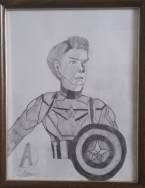I took a mental trip back to preschool at the 2015 New Jersey SCBWI Conference. One quote, from author/illustrator Denise Fleming did the trick: “Every time you draw a picture you begin to tell a story.”
The story of a character…

The story of self…

The story of family and desires…

My teaching background confirms this theory of pictures being the beginning stages of both writing and reading. Most of us explored with crayons, pencils, pens, markers, and more when we were little. Our sense of wonder was ignited and we evolved through each early writing experience.
Some kidlit creatives held onto this passion and took it further to really develop their art. Some completely lost interest. And some, like me, still love and appreciate art, and even think visually. My pencil moves to the beat of a writing drum. But, the pictures in my head drive the story.
Editor Orli Zuravicky of Scholastic says, “You must think visually.” It makes sense that she likes art notes. A picture book marries art and text.

We think about the words as we write. But, do we think about how the illustrations will enhance them? Our words should not say the exact same thing that the picture shows. Author/illustrator Ben Clanton gives a great interplay lesson here and covers the dos/don’ts of art notes, too.
We think about the page turns as we write. But, do we also visualize what they will look like? Does your page turn create tension? Does it surprise the reader? Does it show passage of time? Think in pictures and in words.
We think about plot as we write. But, do we think about a subplot that enhances the pictures?
So, what if you don’t draw? Be a dummy! That is, “dummy it out” as agent Alexandra Penfold suggests. If you are truly not the drawing type, then use your dummy layout to describe in words what would be in the pictures. Dare to take yourself on that visual journey. Who knows, you may evolve just like the pictures above! (You’ve got to start somewhere, right?)
As long as you are willing to connect visually in one way or another, you will continue to evolve, just like my kids.
I wish you the perfect marriage. When art and words go hand in hand it is magical. I now pronounce you a picture book.





This is encouraging to me, as I’m very visual and “see” my picture book as I write.
LikeLike
Great post, Carrie. I love looking at little kids’ art. I’m heading back to the classroom to teach 1st grade this fall and am hoping to get more pb ideas from them!
LikeLiked by 1 person
Best wishes in 1st, Tina! I loved teaching first graders. I hope you do, too.
LikeLike
As you know, Carrie, I enjoy reading, writing and creating everyday. Adding pictures to our manuscripts just seems like the right thing to do as the images enhance the story. Thank you for the encouragment to create a visual image aka dummy to *see* the flow of the story.
The art work that your kids created is delightful. They each have a story to tell.
~Suzy Leopold
LikeLiked by 1 person
Thanks for stopping in for a read, Suzy! Glad it was helpful for you! Have fun dummying it up!
LikeLiked by 1 person
I love this post, Carrie! I especially enjoyed seeing your kids’ evolution of art! And the reminder about words, page turns and plot are greatly appreciated!!!
LikeLiked by 1 person
You are welcome!
LikeLike
Carrie,
I remember an author telling me that there are two stories in every picture book, the writer’s and the illustrator’s. How true it is!
LikeLiked by 2 people